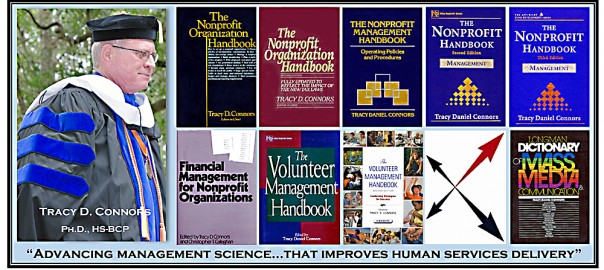Effective Organizations
Effectiveness is one of the three overarching management domains that define and characterize self-renewing organizations, the others including Efficiency and Transformational Organization. An effective organization, regardless of the sector in which it operates, has a valid purpose that is continually adjusted to its surroundings and context as it focuses on how to accomplish its public service, customer-focused mission.
Effective philanthropic-charitable organizations share three broad leadership and management characteristics, including:
• Valid purposes that that serve and satisfy clients, customers, and stakeholders, and that are continually adjusted to and aligned with the organization’s surroundings, context and operating environment. Effective C-P/NP organizations know they are needed—and they know why. They know their public purpose is valid, and they continually adjust it, tune it to environmental conditions to achieve business results (Connors, 1997)
• Business results and mission fulfillment outcomes are the focus for program planning, process and process improvement activities, implementation and evaluation efforts directed at accomplishing its public service purpose through client-driven quality and operational performance excellence.
• Governance leaders are focused on performance excellence, adaptability to the organization’s operating environment, and sustainable mission accomplishment.
The Charitable-Philanthropic Organization Self-Renewing Management Model (C-POSRM) Study (Connors, 2013) reported that Effective charitable organizations:
Know that they serve valid public purposes (Mission and Vision); know they are needed (Community Outreach, Operating Environment); and, they
Know why (Customer/Client-Focused Outcomes, Satisfaction, and Engagement).
Further, effective charitable-philanthropic organizations monitor their operating environment (Operations Focus; Public Relations), and stand ready to adjust their purpose or operations (Strategic Planning, Development, Deployment; Business Results; Leadership and Governance Outcomes; Decision-Making Methods) to ensure they are in tune with ever-changing operational environmental conditions (Assessment and Evaluation Methods; Marketing). Collectively, these actions and activities result in a strategy to achieve better performance and results (Program Implementation, Planning, Evaluation; Business Service/Process, and Workforce-Focused Outcomes; Services, Product and Process Outcomes; Financial and Market Outcomes).
Leadership and Management Practices Fostering Effectiveness
Effective voluntary organizations understand the value of the following leadership and management practices and emphasize their contributions to improved and sustained organization performance and results.
• Customer Focus and Satisfaction as the foundation for setting priorities and focusing improvement activities. Results and trends in this area offer a means to determine the appropriate direction for improvement activities and initiatives. Effective organizations listen to and learn from their customers on a continuous basis, then use that intelligence to determine their current and near-term requirements and expectations.
• Strategic planning is used to define and accomplish their customer-focused mission. Strategic planning to strengthen their customer-related, operational, and financial performance, to improve customer satisfaction. Planning is essential to help organization leaders use customer and operational requirements as inputs to setting strategic directions. Strategic planning guides ongoing decision-making, resource allocation, and organization-wide management.
• Business Results as the focus for all processes and process improvement activities to assess its progress towards superior value of its offerings as viewed by customers and the marketplace, and towards superior organization performance reflected in productivity and effectiveness.
Executives Report Most Valuable Management Actions and Activities
C-PO executives reported the management actions and activities most valuable to them in achieving Effectiveness include such essential elements needed to achieve Effectiveness as:
• Fulfilling the purpose of the organization;
• Proactively serving and satisfying clients and customers;
• Highly focused program planning, implementation and evaluation; and,
• Governance leaders who understand the organization’s operational environment and what must be done to establish and maintain sustainability within that environment – and do so.
Several survey respondents also suggested that an effective C-PO would also have “strong ethics and accountability processes,” “vision and purpose,” “outcome measurement processes,” and, “…a sense of pride.” Another respondent added “funder requirements are really what we have to follow, regardless of our own (or community) ideas of what is effective. Unfortunately, the funders often have an incomplete or even warped idea of what is really effective.”
One Size Does Not Fit All: Effectiveness
C-PO executives rank various management actions and activities differently in their perceived ability to contribute to organizational effectiveness depending on such variables as the size and type of the organization, or the experience of the responding executive. For example, community-based charities, those with the fewest staff members and available resources for management support, ranked as their top five effectiveness components: mission and vision, community outreach, customer engagement, customer satisfaction, and customer-focused outcomes.
Smaller charities, those operating with 10-50 employees, ranked as their top five effectiveness components: mission and vision, customer satisfaction, customer engagement, program implementation, and program planning.
Larger charities, those with more than 50 employees, ranked as their top five effectiveness components: customer-focused outcomes as the strongest component of effectiveness. This was followed by program implementation, mission and vision, program evaluation, and assessment and evaluation methods.
Regardless of their experience, charitable executives concurred that a focus on the organization’s mission and vision was the most important contributor to organizational effectiveness.
Note: Adapted in part and with permission from:
Connors, T. D. (1997). The self-renewing organization. In T. D. Connors (Ed.), The nonprofit handbook: Management (2nd ed.) (pp. 2-29). New York: John Wiley & Sons.
Connors, T. D. (2001). The self-renewing organization. In J. M. Greenfield (Ed.), The nonprofit handbook: Fund raising (3rd ed.) (pp. 1113-1140). Hoboken, NJ: John Wiley & Sons.
Connors, T. D. (2001). The self-renewing organization. In T. D. Connors (Ed.), The nonprofit handbook: Management (3rd edition) (pp. 3-45). New York: John Wiley & Sons.
Connors, T. D. (May 2013). Towards a theory of self-renewed excellence for charitable-philanthropic organizations, Public Service Leadership, Capella University. DAI-A 74/11(E), p. 276. Retrieved from http://search.proquest.com//docview/1427359144
© Copyright 2015 Tracy D. Connors

